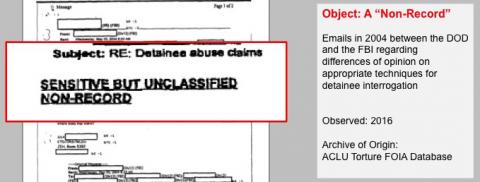
The video below is an investigation of the forms taken by redacted, withheld, and classified government documents and their visible manifestation of hidden state information, with a focus on documents from the George W. Bush administration. Withheld and redacted documents have a special relationship to the concept in Memory Studies of “the presence of absence”: the documents are known to exist, yet their directly readable and perceivable content has been obscured or removed by state agents. Though they often exist in material forms—as black squares placed over text portions or as insert pages stating documents have been excised from the publicly viewable record—their materiality is always coupled with the presence of the unknowable. The “there-but-not-there” form of these documents forces the researcher, journalist, or activist to relate to them around the margins—through their context, placement, hints at reasons for redaction, or ability to point to information that cannot be directly accessed. Their ghostly presence can be analyzed not only through the sociocultural factors of archival rules and practices or the political-historical considerations of FOIA exemptions and glomar, but also through conceptions of the spectre or the ghost: that which exists but does not exist simultaneously. This short video highlights a series of example redacted records to emphasize their material forms and “found-object” contextual information, pointing to the features around their absences that could be examined by a researcher. The video is a mini slideshow exhibition of images and text presented as a “collection of artifacts,” including imagined museum labels—suggestive of an “archaeological” examination into the culture of bureaucracy and documentation related to state power and that power’s attempts to control the historical record. It was designed to run on a continuous loop behind the author during performative readings of a written text concerning redaction and during audience interaction at the readings.
(Past readings took place in 2016 at the Translating Memory & Remembrance Across Disciplines conference at SUNY-New Paltz in workshop form and the 2016 Annual Meeting of the American Anthropological Association in full form.)